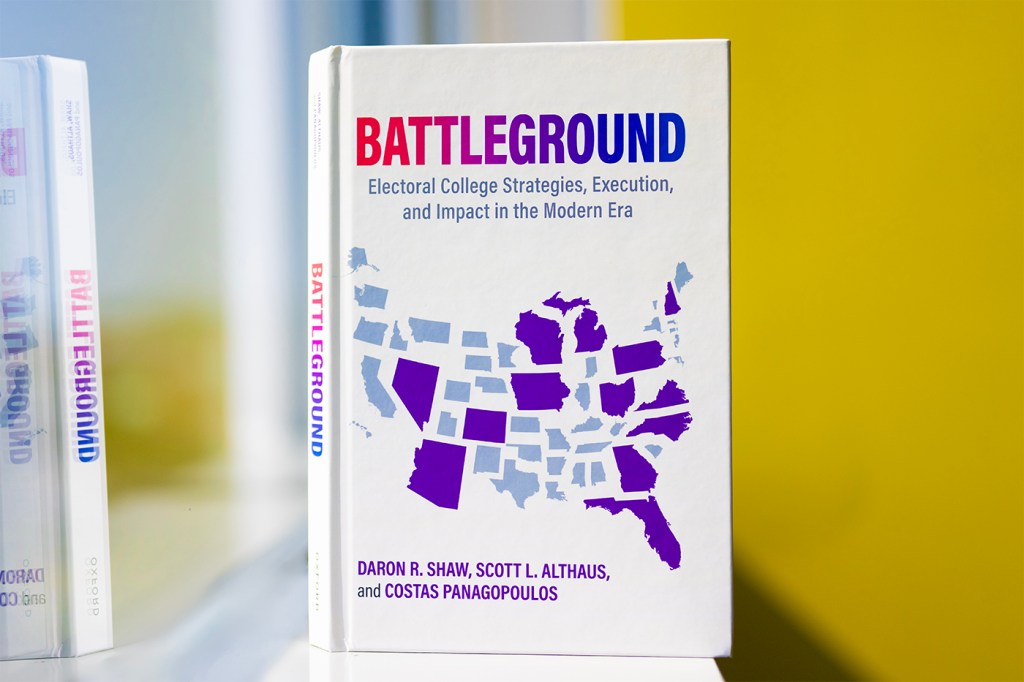New book sheds light on nearly 70 years of presidential campaign strategy
A Northeastern political scientist provides a sweeping account of how the major political campaigns over the last seven decades have managed to strategically deploy their resources to game the Electoral College system.

It’s no secret that politics is a game — one played with winners and losers.
And in America, like it or not, the winner takes all.
The name of the game? It’s all about getting 270 electoral votes. A new book from a Northeastern University political scientist provides a sweeping account of how the major party campaigns over the last seven decades have managed to strategically “deploy their precious resources” to put together a winning coalition toward that magic number.
“Battleground: Electoral College Strategies, Execution, and Impact in the Modern Era,” is more than 20 years in the making, says Costas Panagopoulos, distinguished professor of political science at Northeastern University and co-author of the book published by Oxford University Press.
“Step one was collecting this data and putting it together, which was no small task,” Panagopoulos tells Northeastern Global News. “Equally challenging was organizing the data in a way that allowed us to measure what we were studying consistently over time.”

Daron R. Shaw of the University of Texas at Austin, and Scott L. Althaus of the University of Illinois at Urbana-Champaign, co-wrote the book with Panagopoulos.
Panagopoulos and his colleagues drew from a vast trove of resources — records pulled from private campaign archives and presidential libraries, to insider campaign memos and other materials — to analyze electoral strategies pursued by every major political campaign between 1952 to 2020. The result represents a deep dive into the strategic choices those campaigns made in each of those cycles, at a level of detail previously unavailable.
“Our book focuses on state-level Electoral College strategies, how campaigns tried to get to 270. That’s the broad picture,” Panagopoulos says. “The book does not, however, engage how campaigns spent their money on the ground — and we don’t look at what kinds of messages were featured in ads, or what audiences were targeted.”
What emerged were three distinct eras, beginning in the early 1950s, that tell the story of the evolution of presidential campaigns in terms of how they spent money, targeted voters and relayed platform and policy information to the electorate.
Those time periods are described in the book as the wholesale campaigning era (1952-1972), the zero-sum campaigning era (1976-2000) and the microtargeted campaigning era (2004-2020). The wholesale campaigning era is defined by the rise of “broad-based, mass advertising,” primarily on television, and the development of polling as means of gathering and analyzing data at scale. The authors note that there were few laws to regulate campaign contributions and expenditures during those earlier years.
Featured Posts
The second stretch of time marking the zero-sum campaigning era was significantly shaped by the passage of the Federal Election Campaign Act of 1971, which set limits on campaign spending and donations. This era also featured better information from polling, focus groups and other sources, leading to efficiencies in how campaigns spent their scarce resources.
The third era — which we are currently in — is when presidential campaigns began to forgo public funding and raise their own private funds, often fairly large sums of money. It is also marked by developments in technology, such as digital algorithms, and data availability that allowed campaigns to refine the ways they targeted and reached out to voters, Panagopoulos says.
The book dove into other empirical questions, like how states are classified as battlegrounds over time; how effectively campaigns actually executed their strategies to target voters in these states; and whether campaign spending patterns influenced vote shares.
On the latter: “What we found was not a huge effect, but the relatively small effects that we did detect can be decisive in close contests, like many of our elections have been in recent cycles,” Panagopoulos says.
It’s a timely book, not least because of just how polarized the U.S. has grown in recent years, but because such polarization has made for even tighter elections than in prior cycles. This year will likely prove no exception, with the latest polling showing Harris and Trump neck and neck.
“We show that the emphasis on battleground states was crucial, given the structure of the Electoral College and how presidents get elected in this country,” Panagopoulos says. “And that’s not just the Electoral College framework set forth in the U.S. Constitution, but the winner-take-all feature of the system itself — which is not spelled out in the Constitution, I might add.”
As the decades progressed, the outsized role of swing states became a central throughline. The 2024 presidential election is likely to hinge of just seven key states: Arizona, Georgia, Michigan, Nevada, North Carolina, Pennsylvania and Wisconsin.
“That is a central focus of the book — that the number of battleground states has been shrinking across the decades of our study,” Panagopoulos says. “And if it is the case that these battleground states are going to get most of the attention from campaigns, the implication is that only 20% of Americans will come into direct contact with a campaign or a presidential candidate.”
Panagopoulos says he hopes the book will serve as a useful tool for researchers.
“One of the key contributions of the book is that we put all of this data in an appendix for readers and other researchers to analyze and access, or exploit for their own research endeavors,” he says.











